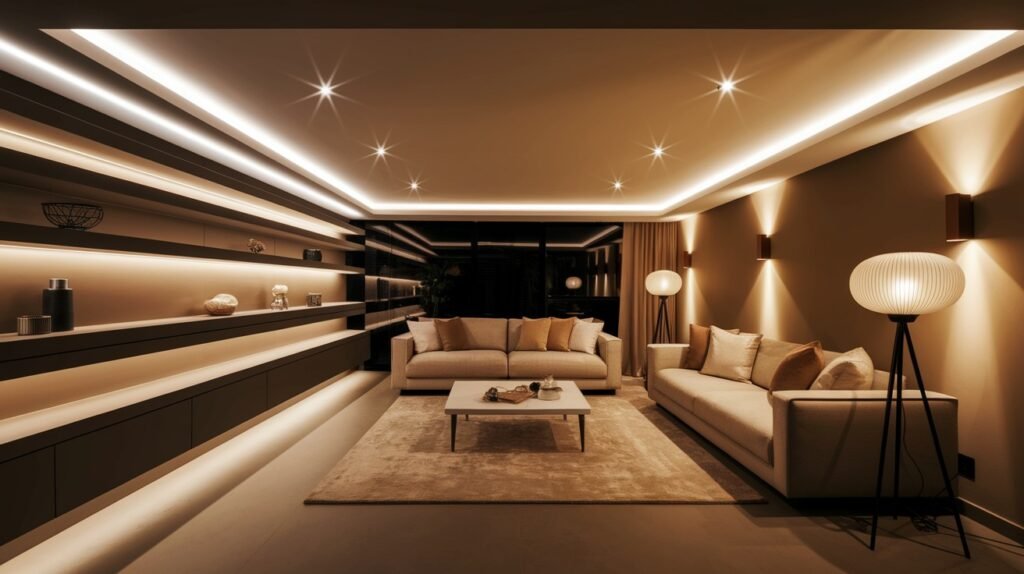Tired of your basement feeling like a forgotten cave?
Your lower level doesn’t have to stay dark and uninviting. With the right approach, you can completely transform this space into something amazing, whether you want a cozy family room, a productive home office, or an entertainment zone.
The secret? Smart basement lighting ideas that work with your space’s unique challenges.
Low ceilings, limited natural light, and tricky layouts might seem like obstacles, but they’re opportunities to get creative.
Here’s what you’ll learn: We’re covering 13 brilliant basement lighting ideas that’ll turn your space from drab to fab.
From budget-friendly fixes to statement pieces, you’ll find solutions that fit your style and wallet. Ready to see your basement in a whole new light? Let’s get started.
Why Lighting Matters in Basements?
Basements often feel dark, cramped, and unwelcoming due to limited natural light and low ceilings. Poor illumination creates safety risks on stairs and makes spaces unusable for activities.
However, strategic lighting transforms these forgotten areas into functional, comfortable rooms. Proper illumination makes ceilings appear higher, defines separate zones, and creates an inviting atmosphere that extends your home’s living space naturally.
Common Lighting Challenges in Basements
- Basements present unique lighting obstacles that can make even the most well-designed space feel unwelcoming. Most basements suffer from limited or nonexistent natural light, creating a cave-like atmosphere that feels disconnected from the rest of your home.
- Low ceilings compound this issue, making traditional lighting fixtures impractical and creating shadows that make the space feel cramped. Many basements also feature exposed ductwork, pipes, or structural beams that can interfere with lighting placement and create uneven illumination.
- Moisture concerns add another layer of complexity. Standard fixtures may not hold up well in humid environments, and electrical safety becomes paramount when dealing with potential water issues.
- Additionally, existing electrical systems in older basements may not support the lighting loads needed for proper illumination.
How Good Lighting Can Upgrade a Space?
Proper lighting completely changes how a basement feels and functions. Strategic illumination can make low ceilings appear higher by directing light upward and eliminating harsh shadows. The right lighting scheme creates visual interest and helps define different areas within an open floor plan.
Good lighting also improves safety and functionality. Adequate illumination prevents trips and falls on stairs, makes reading and detailed work possible, and creates a more secure environment.
When done well, basement lighting can make the space feel like a natural extension of your main living areas rather than a separate, forgotten zone.
The psychological impact is equally important. Bright, well-lit spaces feel more welcoming and comfortable, encouraging family members and guests to spend time there.
Proper lighting can also make your basement feel larger and more open, maximizing the perceived value of your square footage.
Functional vs Decorative Lighting Needs
|
Functional Lighting |
Decorative Lighting |
|
Primary Purpose: Task completion and safety |
Primary Purpose: Ambiance and visual appeal |
|
Brightness Level: High illumination (2000-4000 lumens) |
Brightness Level: Moderate to low (500-1500 lumens) |
|
Placement: Work areas, stairs, walkways |
Placement: Focal points, corners, accent walls |
|
Fixture Types: Recessed lights, track lighting, under-cabinet strips |
Fixture Types: Pendant lights, sconces, statement pieces |
|
Color Temperature: Cool white (4000-5000K) for alertness |
Color Temperature: Warm white (2700-3000K) for comfort |
|
Control Options: Bright switches, motion sensors |
Control Options: Dimmers, smart controls, multiple scenes |
|
Cost Priority: Efficiency and longevity |
Cost Priority: Style and visual impact |
|
Installation: Often hardwired, permanent placement |
Installation: Mix of hardwired and plug-in options |
|
Examples: Overhead ceiling lights, stair lighting, workspace illumination |
Examples: Chandeliers, accent lighting, decorative table lamps |
How to Choose the Right Lighting for Your Basement?
Understand the Purpose of Your Basement (Lounge, Gym, Office, etc.)
Your basement’s intended use determines lighting requirements.
- Home offices need bright, focused task lighting to reduce eye strain during computer work.
- Gyms require even, shadow-free illumination for safe exercise.
- Entertainment areas benefit from dimmable ambient lighting that creates a cozy atmosphere for movie nights.
- Storage spaces need practical overhead lighting for visibility. Multi-purpose basements require flexible lighting systems that adapt to different activities throughout the day.
Consider Ceiling Height, Layout, and Existing Fixtures
Low ceilings limit fixture options, making flush-mount or recessed lights ideal choices. Exposed beams create shadows, requiring strategic placement to ensure even coverage. Assess your electrical capacity before adding new fixtures.
Long, narrow basements need multiple light sources to prevent dark spots. Open floor plans allow for creative zoning with different lighting types.
Work around existing HVAC ducts and plumbing to plan fixture locations that won’t interfere with maintenance access.
Color Temperature and Brightness Tips
Cool white light (4000-5000K) works best for task areas like workshops or home offices, promoting alertness and focus. Warm white (2700-3000K) creates a comfortable ambiance in living spaces and bedrooms.
Aim for 20-30 lumens per square foot for general lighting, increasing to 50+ lumens for detailed tasks. Layer different brightness levels throughout the space.
Dimmable fixtures offer flexibility for various activities and times of day, allowing you to adjust intensity as needed.
13 Amazing Lighting Ideas for Your Basement
1. Recessed Lights
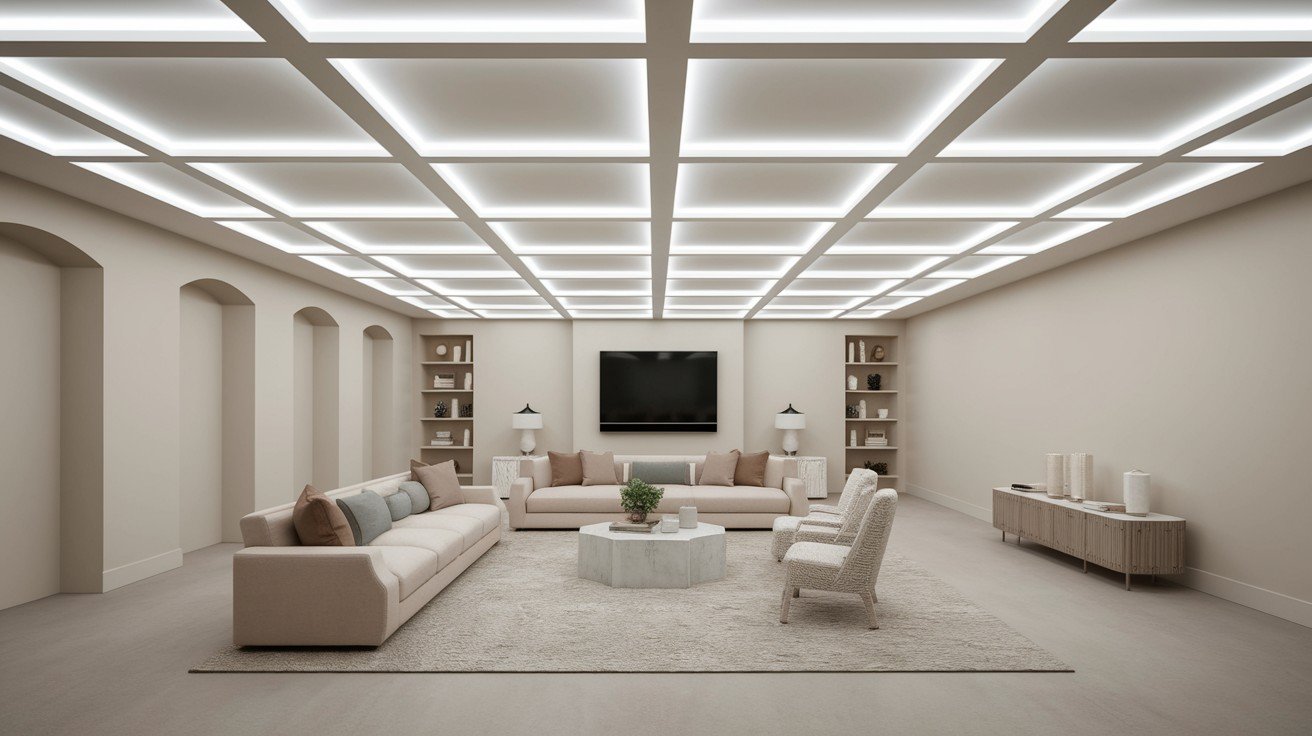
Recessed lights sit flush with the ceiling, perfect for basements with limited headroom. They provide clean, unobtrusive illumination without taking up visual space.
Install them in a grid pattern for even coverage or focus on specific areas. LED options offer energy efficiency and long lifespan. Choose adjustable trims to direct light where needed while maintaining that streamlined appearance.
2. Track Lighting
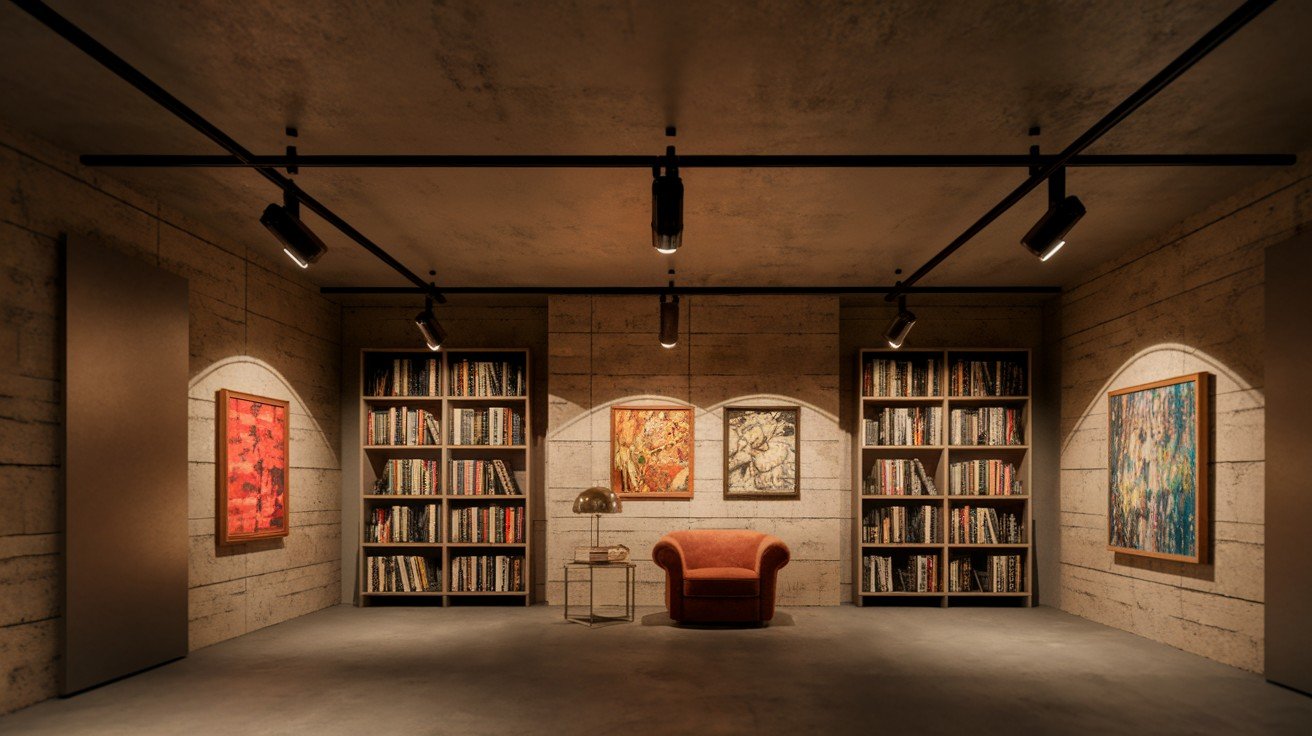
Track lighting systems offer ultimate flexibility for basement spaces. Individual fixtures slide along the track, allowing you to reposition lights as your needs change.
Perfect for highlighting artwork, illuminating work areas, or creating focused reading spots. Multiple track circuits enable different lighting scenes.
Modern track systems come in various finishes to complement your basement’s style while providing targeted illumination.
3. Pendant Lights
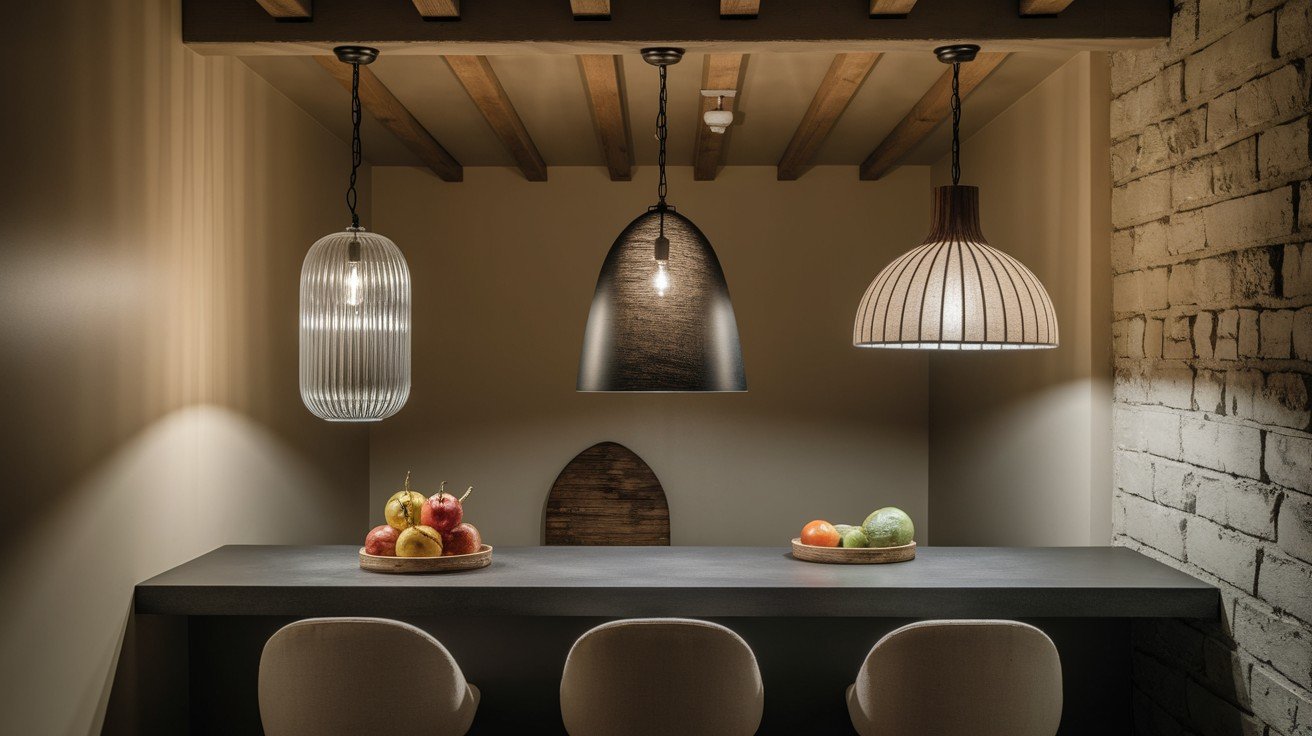
Pendant lights bring style and character to basement spaces while providing focused illumination. Hang them over kitchen islands, dining areas, or seating zones to create defined spaces.
Choose from industrial metal shades, fabric drums, or glass globes to match your decor. Multiple pendants at varying heights add visual interest. Ensure adequate clearance from the floor – typically 7 feet minimum for walkways.
4. Wall Sconces
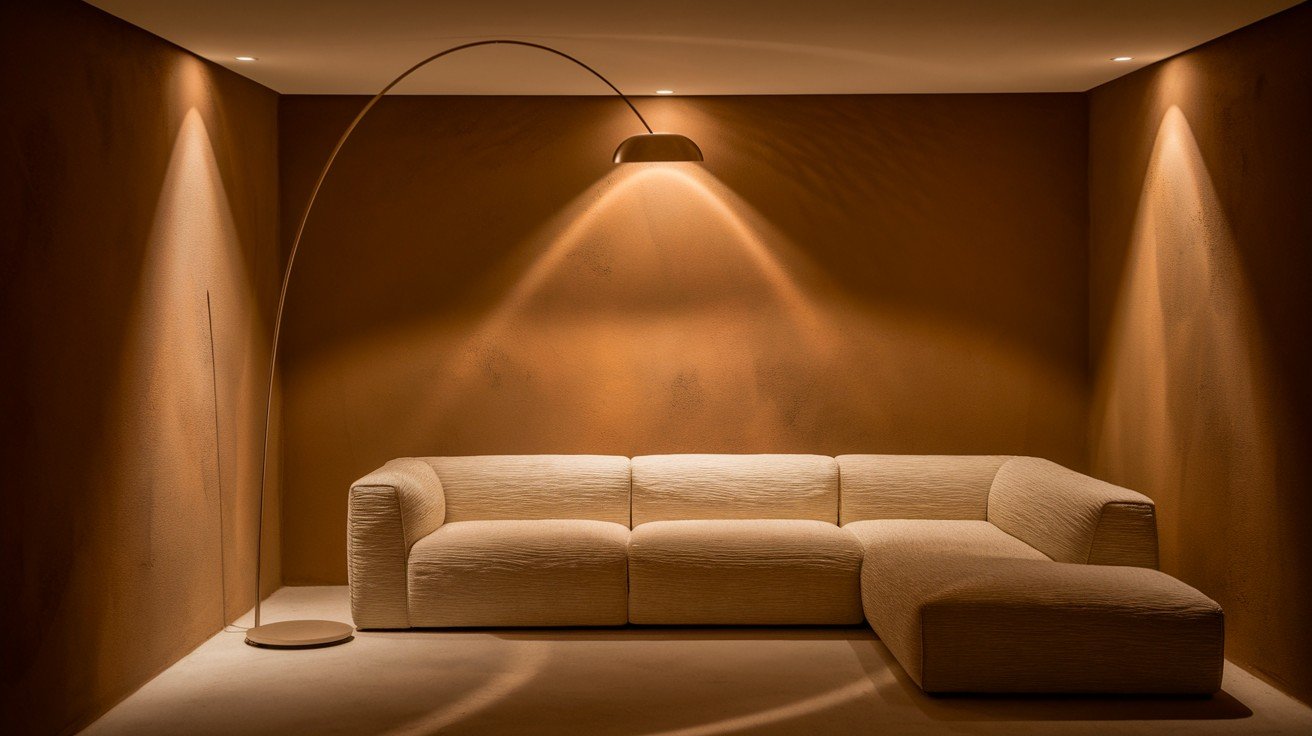
Wall sconces create warm, indirect lighting that makes basements feel cozy and inviting. Mount them at eye level along hallways, beside seating areas, or flanking entertainment centers.
They free up floor and table space while adding architectural interest to plain walls.
Choose uplighting sconces to make ceilings appear higher, or downlighting versions for task illumination. Battery-powered options work well where hardwiring isn’t feasible.
5. Floor Lamps

Floor lamps offer portable lighting solutions that adapt as your basement layout changes. Position them beside reading chairs, in dark corners, or behind sofas for ambient lighting. Torchiere styles bounce light off ceilings to brighten the entire space.
Arc lamps extend over seating areas without requiring overhead fixtures. Choose lamps with multiple brightness settings and USB charging ports for added functionality in modern basements.
6. Cove Lighting
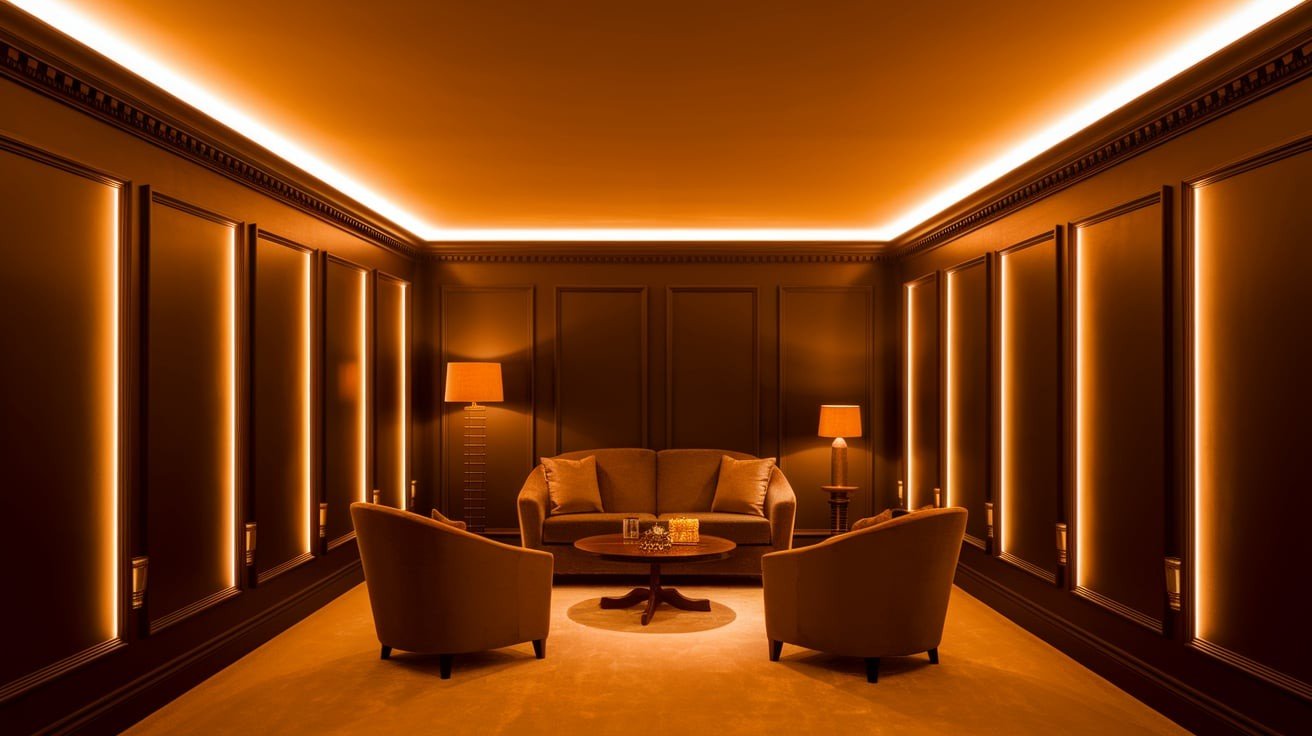
Cove lighting creates sophisticated indirect illumination by hiding LED strips behind crown molding or recessed ledges. This technique makes ceilings appear higher and adds architectural drama to plain basement walls.
The soft, even glow eliminates harsh shadows while creating a premium atmosphere. Install dimmers to control intensity for different moods.
Cove lighting works especially well in media rooms, home bars, or formal seating areas.
7. LED Strip Lights
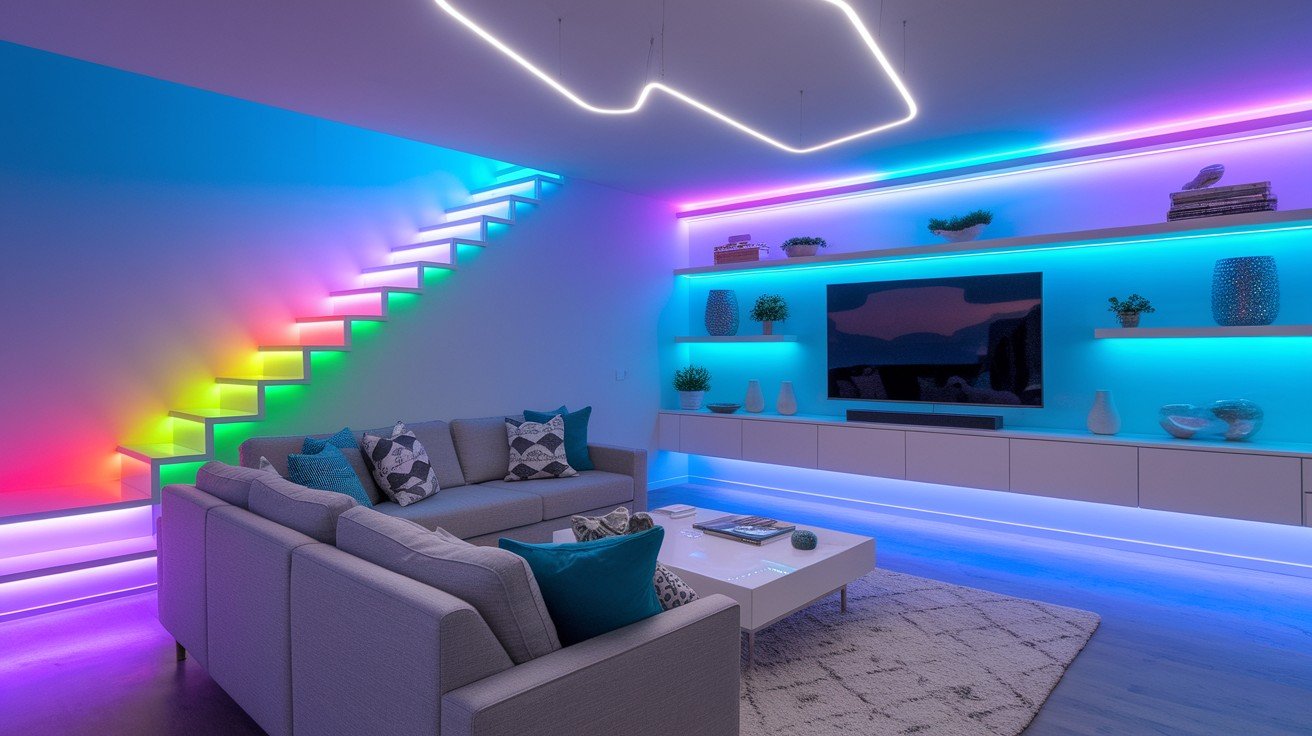
LED strips offer endless possibilities for creative basement lighting. Install them under stairs for safety, behind TVs to reduce eye strain, or along baseboards for pathway lighting. Color-changing strips create dynamic atmospheres for entertainment spaces.
Use them to outline architectural features, highlight shelving, or create accent borders. Waterproof versions work well in humid basements.
Smart strips connect to apps for custom colors and patterns.
8. Flush-Mount Ceiling Fixtures
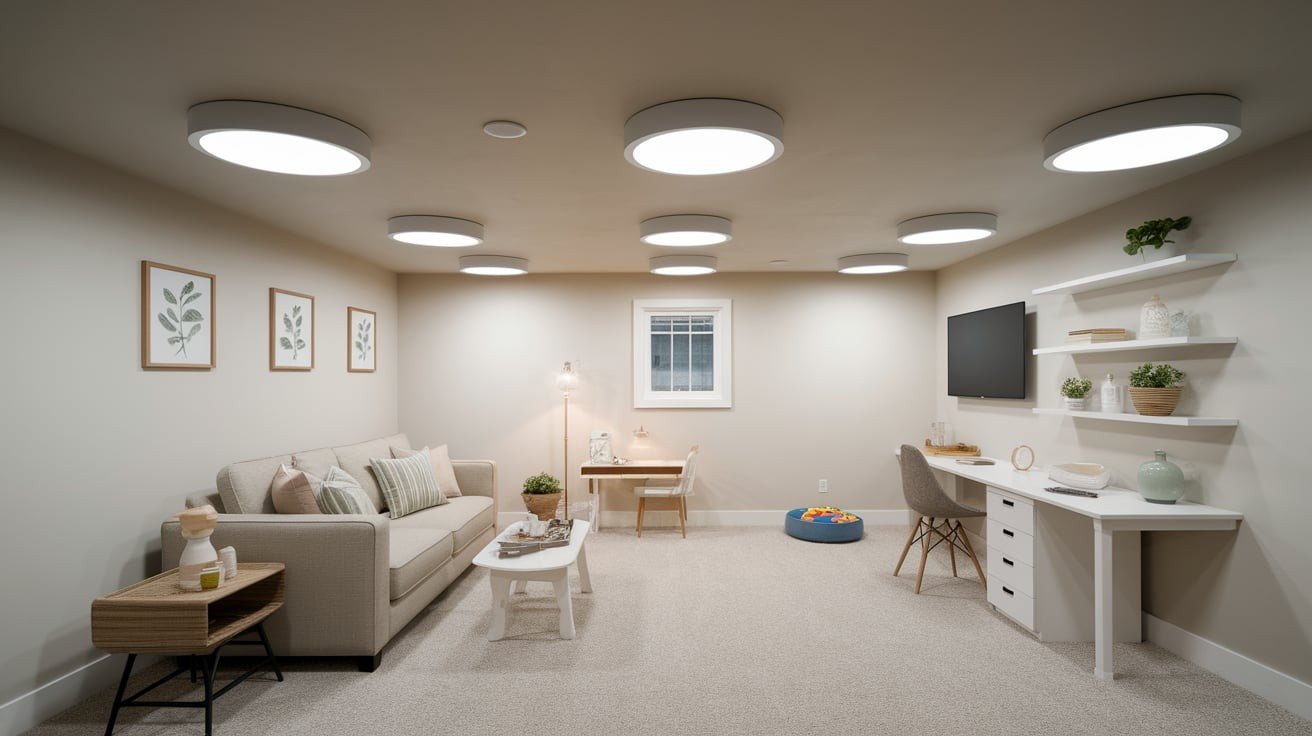
Flush-mount fixtures solve the common basement problem of limited ceiling height. These fixtures sit directly against the ceiling, maximizing headroom while providing general illumination.
Modern designs range from simple drum shades to decorative glass patterns. LED versions offer bright, energy-efficient lighting. Choose fixtures with diffused covers to prevent glare.
Multiple flush-mounts spread throughout the space ensure even coverage without creating harsh shadows or dark spots.
9. Smart Lighting

Smart lighting systems let you control brightness, color, and timing from your smartphone or voice commands.
Create preset scenes like “Movie Night” with dimmed ambient lighting or “Work Mode” with bright task illumination. Schedule lights to gradually brighten in windowless basements, mimicking natural daylight patterns.
Smart switches work with existing fixtures, while smart bulbs offer color-changing capabilities. Group multiple lights for synchronized control throughout your basement space.
10. Daylight LED Bulbs

Daylight LED bulbs (5000-6500K) replicate natural sunlight, combating the cave-like feel of windowless basements. These bulbs improve mood and energy levels while making colors appear more vibrant and true-to-life.
Use them in work areas, craft rooms, or anywhere you need accurate color perception. Full-spectrum options can help with seasonal mood changes.
Pair with warm white bulbs on separate circuits for versatile lighting throughout the day.
11. Lighted Mirrors
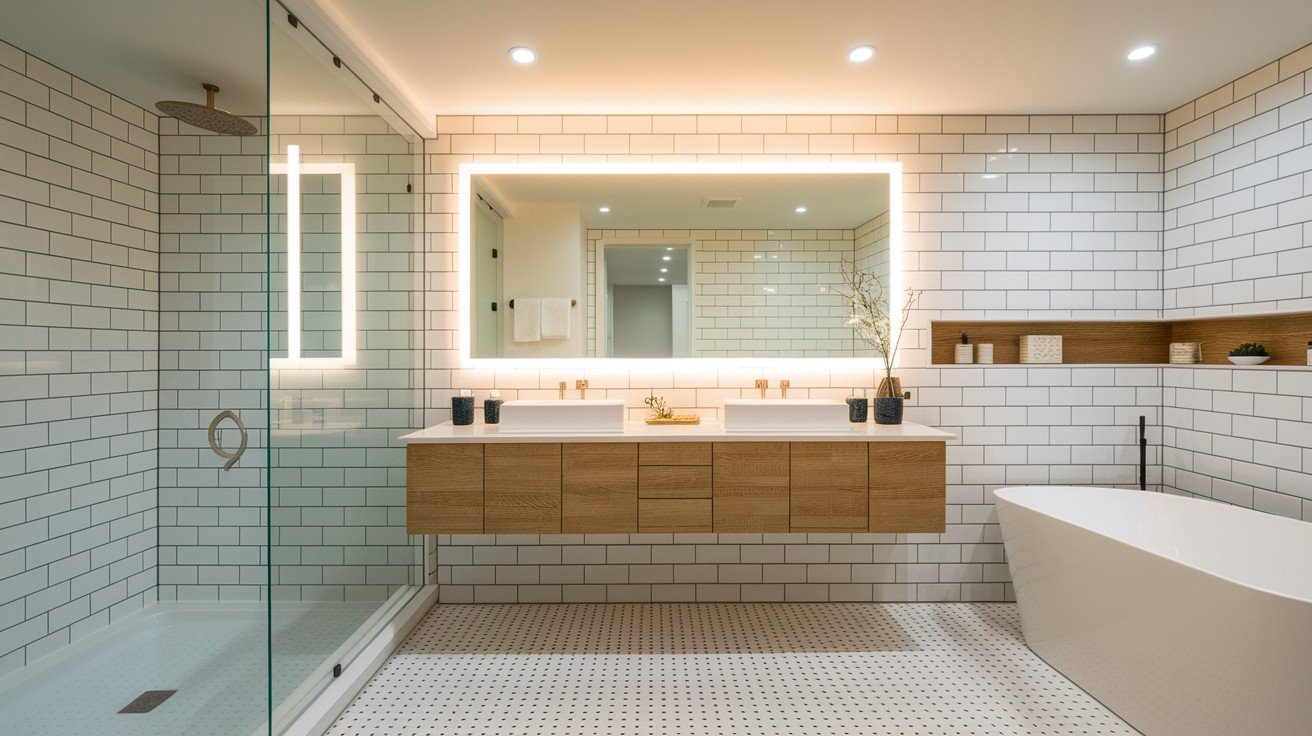
Lighted mirrors provide even, shadow-free illumination for grooming tasks while saving wall space. Built-in LED strips eliminate the need for separate vanity lighting.
Choose mirrors with adjustable color temperature to switch between bright daylight for detailed tasks and warm light for relaxation.
Fogless options work well in humid basement bathrooms. Some models include magnification sections, USB charging ports, or Bluetooth speakers for added functionality.
12. Under-Cabinet Lighting
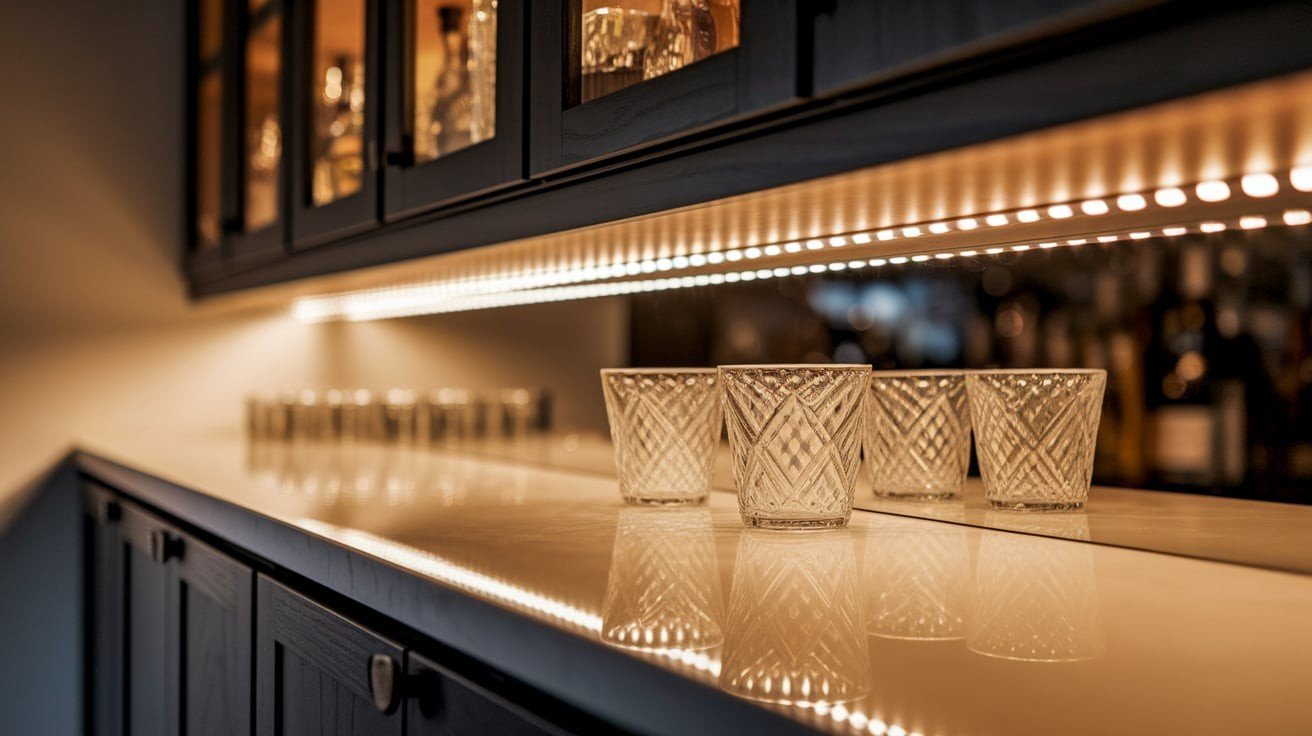
Under-cabinet lighting eliminates shadows on countertops, making food prep and bartending safer and more enjoyable.
LED strips or puck lights mount easily beneath upper cabinets, providing focused task illumination. Choose warm white for cozy bar atmospheres or cool white for functional kitchen work. Battery-powered options avoid electrical work, while hardwired versions offer consistent power.
Dimmable controls let you adjust brightness from bright task lighting to subtle ambient glow.
13. Motion-Activated Lights
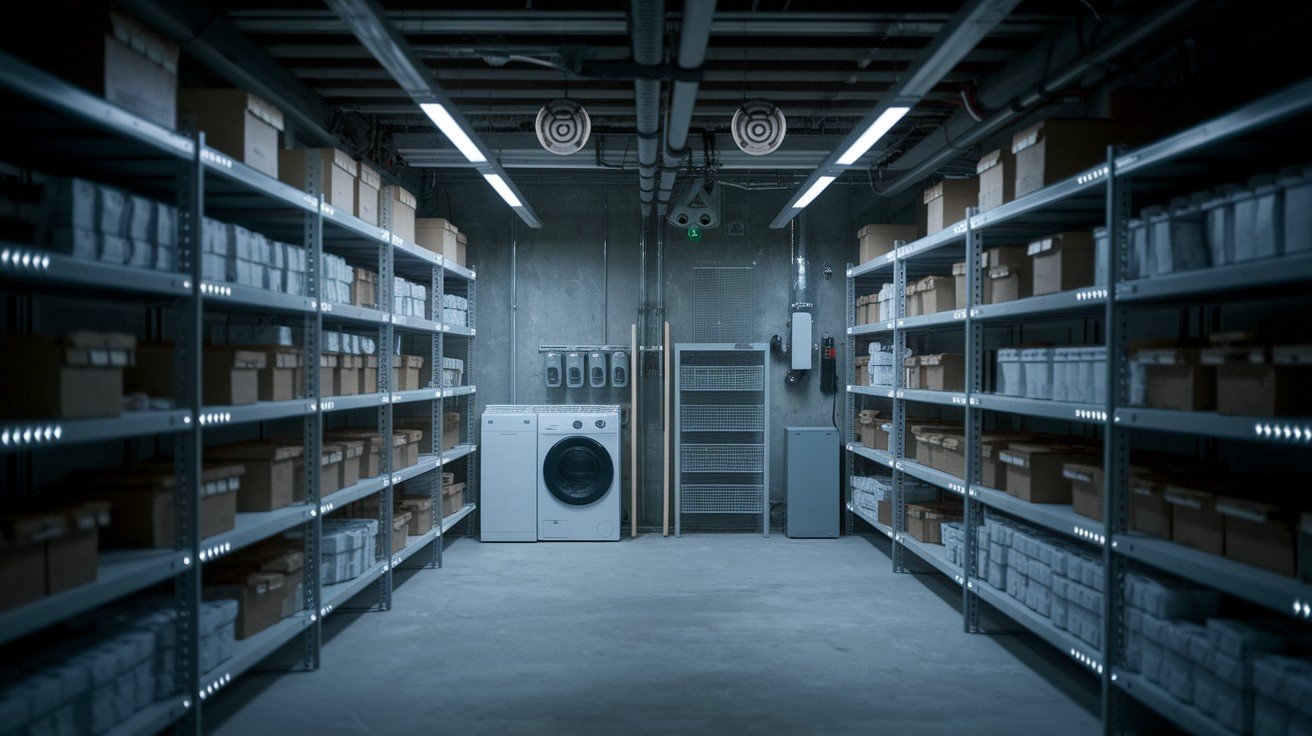
Motion sensors automatically illuminate basement utility areas, stairways, and storage rooms when you enter.
These lights improve safety while conserving energy by turning off when spaces are empty. Install them near furnaces, water heaters, or laundry areas for hands-free convenience. Battery-powered versions work anywhere without wiring.
Adjustable sensitivity and timer settings customize performance. Choose LED fixtures for long life and instant-on capability in frequently accessed utility zones.
Lighting Styles That Work Well in Basements
Industrial and Exposed Fixtures
Industrial lighting complements basement architecture with its raw, utilitarian appeal. Exposed Edison bulbs, metal cage pendants, and galvanized track systems work beautifully with concrete walls and exposed beams.
Black iron fixtures add masculine character, while copper and brass options warm up the space. Industrial styles embrace imperfection, making them forgiving of basement irregularities.
These fixtures are typically durable and functional, perfect for workshop areas or modern man caves with an urban edge.
Modern Minimalist Designs
Clean lines and simple forms define modern minimalist basement lighting. Geometric pendant lights, sleek recessed fixtures, and linear LED systems create uncluttered spaces that feel larger and more open.
White or brushed metal finishes reflect light efficiently while maintaining visual simplicity. Hidden lighting sources like cove strips and toe-kick illumination enhance the streamlined aesthetic.
This style works especially well in contemporary basements with smooth walls and modern furnishings.
Rustic or Farmhouse Touches for Cozy Vibes
Rustic lighting creates warm, inviting basement retreats through natural materials and vintage-inspired designs. Wood beam chandeliers, mason jar pendants, and wrought iron sconces add farmhouse charm.
Lantern-style fixtures and rope-wrapped elements bring outdoor cabin feelings indoors. Warm Edison bulbs enhance the cozy atmosphere with their amber glow.
This style pairs beautifully with exposed brick, wood paneling, or stone walls, creating comfortable family gathering spaces with homey appeal.
Tips for Installing Basement Lighting Safely
- Assess electrical capacity before adding fixtures by checking your panel’s available amperage and ensuring circuits can handle additional lighting loads without overloading breakers or creating fire hazards.
- Choose moisture-resistant fixtures rated for damp locations, especially near water heaters, laundry areas, or in humid basements where condensation occurs regularly throughout the year.
- Plan for low ceiling clearance by selecting flush-mount or recessed fixtures that provide adequate headroom while meeting local building codes for minimum ceiling height requirements.
- Call a licensed electrician for new circuit installation, panel upgrades, or any work involving main electrical connections, while simple fixture swaps on existing circuits can often be DIY projects.
- Install GFCI protection on all basement lighting circuits to prevent electrical shock hazards, especially in areas where moisture is present or where concrete floors increase conductivity risks.
Conclusion
Your basement doesn’t have to remain a dark, forgotten space. With these lighting ideas, you can create a bright, functional area that adds real value to your home.
From budget-friendly LED strips to statement chandeliers, there’s a solution for every style and budget.
Remember to prioritize safety by checking electrical capacity and choosing moisture-resistant fixtures where needed. Layer different types of lighting, ambient, task, and accent, to create depth and functionality.
Whether you’re building a home theater, office, or family room, proper illumination makes all the difference.
Start with one or two key fixtures and build your lighting plan over time. Your basement has incredible potential; the right lighting will help you realize it. Transform that underused space into your favorite room in the house.
Frequently Asked Questions
What’s the best lighting for low basement ceilings?
Flush-mount fixtures and recessed lights work best, providing adequate illumination without reducing headroom or creating visual clutter.
How many lumens do I need for basement lighting?
Aim for 20-30 lumens per square foot for general lighting, increasing to 50+ lumens for detailed tasks like reading.
Can I install basement lighting myself?
Simple fixture swaps are DIY-friendly, but new circuits, panel work, or complex installations require a licensed electrician.

